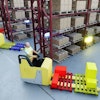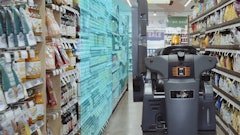
With new COVID-19 variants continuing the supply chain flow disruption, consumers remain motivated to do most of their shopping online. The demand has inevitably branched out to perishable items, such as groceries, which were mainly feasible to buy in stores. With this consumer shift in mind, many retailers are willing to explore grocery automation solutions to streamline processes and ensure high-performance operations.
Relatively late into the game, groceries as a product category has been quite slow to join e-commerce. This labor-intensive industry requires handling numerous bulky cases and working at high speeds throughout the day. Simultaneously, warehouse staff is subjected to ambient, refrigerated and below freezing working environments, risking exposure to a multitude of health risks.
The sector also deals with low-profit margins, difficulties with picking and delivering and the slowing rate of manual picking. Furthermore, groceries vary significantly in size and weight, carry low value, are perishable and require storage at various temperatures. All these factors lead to retailers struggling to find a suitable solution to meet consumer requirements efficiently.
It is evident that speed is an essential component of this process. Within a few years, the time needed to meet those consumer requirements dropped from two days to a couple of hours. Automating warehouse operations is not a leftover choice anymore. As LogisticsIQ reports, online grocery in the United States was $130 billion or 12.5% of overall grocery sales and will reach $250 billion or 21.5% of overall grocery sales in the United States.
Machine vision: A crucial aspect of grocery automation
Almost every sector globally is reaping the benefits of machine learning, with businesses stepping up to more advanced processes. A small portion of highly automated operations relies on deep learning, where artificial neural networks learn from a massive amount of data. These deep-learning systems learn to recognize features that are independent of the objects in order to generalize over a broad range of items over time. This enables robots to take over mundane manual activities and save a huge chunk of business expenses.
Machine vision has made advanced warehouse operations such as picking and placing various items or even depalletizing possible without much human intervention. Embedding robust vision technology in picking robots allows for easy segmentation and classification. Grocery picking using artificial intelligence (AI) entails determining the best “pick point” and classifying random items robustly, whilst ensuring quality control. Unsurprisingly, the machine vision market is expected to grow by 10 times to cross the $1 billion mark by 2030 within the intralogistics sector. Feeding that growth are many integrators developing cutting-edge robotic picking cells for their end-users, aiming to increase revenue in the grocery sector.
That said, machine vision remains an unsung hero of the fast-paced growth of the online grocery market that is expected to reach around $550 billion in the Top 10 countries by 2026.
Advances in machine vision accelerate micro-fulfillment
In fact, micro-fulfillment, a trending buzzword when talking about grocery automation solutions, employs machine vision to enable order fulfillment, from receiving, storing and picking to packing and shipping. Furthermore, it contributes to efficient tech-based order picking, is easier to establish and reduces operational costs. Up until recently, grocery warehouses would traditionally employ goods-to-person (G2P) automation solutions. However, the recent introduction of piece picking robots driven by robust vision technology enables goods-to-robots (G2R) systems.
Conclusion
Regular online purchases have increased up to 5.7% from 2018-2021 in the United States. Over one-third of online grocery shoppers will practice the same online grocery shopping habits after the pandemic ends and more than one-fourth plan to increase online grocery shopping after the crisis subsides. All data implies that consumers’ comfort is increasing substantially despite the pandemic. Whereas, grocery retailers are still revamping their order fulfillment strategies.
Until 2019, the technology behind robotic piece-picking solutions didn’t seem realistic enough to address manual applications. To bring such robotic systems into real-life production, many established system integrators have partnered with companies specializing in sensors, grippers or software elements. They collaboratively ensure that all these components come together to deliver robust robotic piece-picking technologies for end-users. Earlier, the robotic piece picker could not handle item variations due to limitations with machine vision technology, but companies empower all robots to handle variations both robustly and smoothly.
Therefore, it is finally not only reasonable but essential for grocery retailers to join forces with automation and ride the wave of the expected growth for order picking automation worth $3 billion by 2026, driven by e-commerce and e-grocery.



















